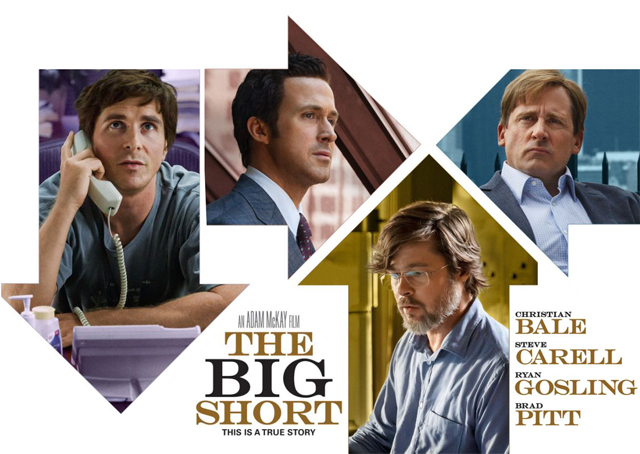FILM | GO LONG ON THE BIG SHORT
by Florence WalkerAdapted from Michael Lewis’s book of the same name, The Big Short is an education in what caused the 2008 financial crisis. It’s informative about without being patronising, and unveils the moral realities of the financial world without being preachy. The flashes of genius in the soundtrack and editing are slicker than the most expensive suits on Wall Street. It is a boisterous, irreverent and intelligent romp.
Casting is superb. Steve Carrell cements himself as an serious actor who just happens to be funny. Brad Pitt and Ryan Gosling manage to keep a lid on their sex appeal. Christian Bale delivers a performance of Michael Burry’s socially awkward character with a sensitivity that deserves special note. And Director Adam McKay uses his background in comedy to stop it all from feeling like homework.
By following the few traders and funds who were suspicious of the ‘unshakeable’ U.S. housing market, complex financial instruments are explained in context with ease. While Wall Street: Money Never Sleeps explained the crash as a result of “moral hazard” (a jumped-up term for the decisions we make when we know we won’t suffer punitive consequences [which only works if you know what the outcome of your actions are]) and Wolf of Wall Street focused on the kind of incorrigible, irresponsible personalities that are attracted to work in financial services, The Big Short takes a holistic approach to explaining the catastrophic events of 2008 that markets still feel today. It doesn’t shy away from the technical details or ignore the greed and ignorance of the man on the street that fuelled the bubble. It demonstrates how the largest crash since 1929 was systemic and not the result of an individual institution, person or psychological trait. Rather than pointing the finger at the Fat Cats upstairs, it illuminates the horrible truth; that everyone was unwittingly complicit.
Exposition in difficult narratives is always a headache to execute elegantly. Fortunately because the situation was too complex for any one trader to properly understand (apart from social recluse and trader, Michael Burry M.D.), you learn with the leading characters as they learn. And when specific instruments that are too complicated to explain by conversation, McKay breaks the forth wall, giving you Margot Robbie in a bubble bath explaining what the hell “sub-prime” is, straight to camera. Or Richard Thaler, father of behavioural economics at a Black Jack table telling us why synthetic C.D.O.’s are toxic. Actually that’s down to teeny bopper, Selena Gomez. If Selena Gomez can understand the ins and outs of betting on the outcome of other bets, so can you.
This isn’t to say that anyone with I.Q. under 120 is going to be able to follow the script. Some understanding for the diversity of appetite for risk (how big a gamble you want to make) is essential. A quick skim of Tetsuya Ishikawa’s semi-autobiographical novel How I Caused The Credit Crunch, or indeed Michael Lewis’s original work wouldn’t go amiss if you haven’t picked up a newspaper in the last decade.
Unfortunately, the people that need to see and understand this film probably won’t. They’re the people that deem everyone who works in finance a “banker wanker”. But characters like Mark Baum (played by Steve Carell) illustrate that within finance are people who are on a mission to redress imbalances in financial markets that cause untold devastation.
They just can’t work out how yet.


